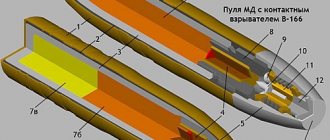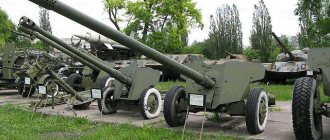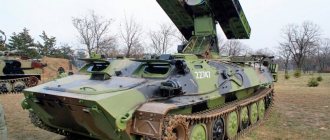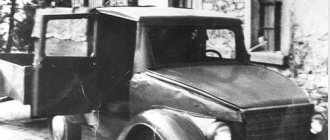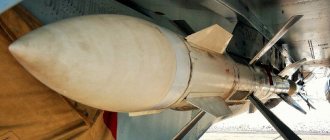Article published 07/30/2014 18:06 Last edited 07/31/2014 06:07
GAZ-69A
GAZ-69A This car was designed by Gorky. We took the serial GAZ-67 as a starting point and... Everything was redone. The main components and assemblies were used from the most modern cars at that time: GAZ-51, Pobeda, Zil. If the previous all-terrain vehicle was a typical wartime product, then the current one met the requirements of the peace period. This was emphasized in the official name of the car - “hard worker”. Although there was a certain amount of pharisaism present here. In the technical specifications for GAZ-69
it is clearly indicated: “Tower of battalion guns and mortars.”
The first copies of the car were slightly different from the production ones. The hood line is slightly different, the windshield is a little different, but in general the appearance of the “Kozlik” has not changed for many years. Why "Kozlika"? Yes, that’s what people called this bouncy all-terrain vehicle. The stiff suspension and narrow wheelbase made the car react quickly to every bump. At maximum speed it became not so much fun as dangerous. Otherwise, “Kozlik” was beyond praise. Neither the English Land Rover nor the American Willys could compete with our all-terrain vehicle on rough terrain. And in terms of equipment, our jeep looked solid. There was a cabin fan and even a heater.
Two years after the launch of the series, production of “Kozlikov” from Gorky to Ulyanovsk. The change of registration was reflected in the radiator grille. From now on, the cars are called UAZs, and more often - UAZs.
GAZ-69A
I open the narrow door (by the way, the back and front are the same - unification!). Images from childhood films immediately come to mind: endless virgin fields, tormented by a blizzard or playing with tall wheat, and a tall, stately chairman, say, Foma Gordeich, strict but wise, rarely smiling widely. And here is another episode: the border patrol is in a hurry to catch the insidious intruder. The outcome of the confrontation is known in advance, but this does not affect the interest of the audience...
To travel in winter, dressing according to current fashion is unforgivable frivolity. The stove in the car is quite decent, but it only heats while driving - there is no fan. In addition, from the interior, covered with a tarpaulin, the street is clearly visible through numerous cracks.
But anyone who drives a GAZ car (even in the back seat - here, in the GAZ-69A, it is normal, by the way, there are no longitudinal benches, as in the usual 69), is always ready for any hardships and hardships, whether military service or the one where they are fighting the “battle for the harvest.” Therefore, I got used to crawling through a narrow door (getting out, by the way, is even more difficult) and squeezing myself between a leatherette seat and a cold plastic steering wheel, not only in an overcoat and padded jacket, but sometimes in a sheepskin coat. With the gas pedal almost pressed to the powerful tunnel of the body, the experienced ones operated, some in boots, some in felt boots. And I, even in ordinary, civilian shoes, out of unaccustomment, first press... on the tunnel.
GAZ-69A
But first you need to pull out the choke button (remember what that is?) and manage to press the very high starter pedal with your right foot. Having warmed up, the lower-valve engine - an analogue of the Pobedov engine - operates sedately and smoothly. Getting comfortable with the clutch is not at all difficult, although the effort is, of course, serious - male. But the gear shift is to a certain extent standard. We have already begun to forget how short and clear the strokes of the lever were when it entered directly into the box. The unsynchronized first one requires skill to turn on silently. But those who have mastered this simple craft have little reason to be proud. Brakes? Like almost all cars of that time. At first there is a long, free movement without resistance, and then the leg finally feels a serious obstacle, and the car, without zeal, very reluctantly, begins to slow down. It’s normal for the life for which a fighter on two fronts was being prepared... We’re already completely late! The fifty-horsepower engine accelerates the gas car faster than I expected. The outskirts are behind, take a dirt road to the highway.
DISTRICT DAYS
GAZ-69A
To the left and right of the speedometer are lamps for external instrument lighting.
To the left and right of the speedometer are lamps for external instrument lighting.
A GAZIK with the front axle engaged and a GAZIK without it are completely different cars. In the 4x2 version, it is better not to stop on a snowy and icy road. A slightly small hill or higher snow - we won’t move. And if it succeeds, the serious-looking car will spin frivolously with its stern. But in the all-wheel drive version, the car overcomes off-road conditions with the tenacity of a bear that has not had enough before hibernation. If you turn on the first low gear (according to the instructions, the speed is no more than 10 km/h!), you can drive into very scary-looking snowdrifts. You just need to be prepared for the fact that the car turns with the front axle engaged, but without any blocking it is very reluctant. There can be no talk of any quick maneuvering! On a flat country road you can safely maintain a speed of 50 or even 60 km/h. But then you understand: the car was not nicknamed “goat” for the sake of a nice word. Instinctively, you squeeze the steering wheel with your hands tighter so as not to fly off the seat and hit your head on the crossbar of the awning; your foot slips off the accelerator pedal. Well... goat! But there is nothing dirty in this word! Especially from a village point of view. The goat, although capricious and jumping, gives milk. Well, the goat is involved in the production of kids.
Cooling system
We replaced the original cooling fan with an electric one and attached it to homemade brackets. The toggle switch that controls the fan has three positions: 1. Automatic switching on (from the sensor, of course) 2. Forced on 3. Forced off Airflow, apparently, is noticeably better than that of the original fan.
The thermostat for our Gas-69 was installed from a Niva VAZ-21213 . Now the car warms up faster and, in theory, should maintain the temperature and not overheat, although tests will tell.
GAZ-69A
In this - the commander's, or chairman's, version of the goat - there is a quite decent rear sofa.
In this - the commander's, or chairman's, version of the goat - there is a quite decent rear sofa.
We jumped onto the highway, and here it’s quite possible to walk at a speed of 70–80 km/h.
But even in this educational mode in modern times, there are enough emotions. The noise from the engine and transmission (what toothy tires!) trains you to develop a commanding voice and communicate with fellow travelers in a raised voice. On a straight line the car is surprisingly strong, but in turns you have to be extremely careful. It's not just about the rolls. The wayward “goat” follows the turn of the steering wheel very reluctantly and slowly. And feeling the trajectory with a steering wheel with such play (not a malfunction, the norm!) is a somewhat exciting activity, but not always safe. DIRECT TRANSMISSION GAZ-69 and -69A were on the assembly line for almost 20 years - from the Cold War era to the times of “détente and peaceful coexistence of the two systems.” By the way, this car is just from that world - produced in 1971.
Advantages and disadvantages
Pros of the car
- High-quality and reliable metal body;
- Good ride height;
- Excellent cross-country ability of the vehicle;
- Availability of all-wheel drive system;
- It is possible to transport small trailers;
- You can drive with the top open or closed;
- Small dimensions of the car;
- There are windshield wipers;
- Stove installed;
- There is a pre-heater;
- The designers made a small luggage compartment;
- The spare wheel is conveniently located;
- The car can carry up to 6 passengers in the rear;
- Unpretentiousness and ease of maintenance.
Cons of the car
- There are no hydraulic power steering and brake systems of the car;
- There are no adjustments to the steering wheel or seats;
- Simple interior without a hint of comfort;
- On a bad road it shakes so much that everyone starts jumping, so you have to hold on to the handrails well;
- The stove works strangely, it’s very hot right next to it, but a cold, piercing wind is already blowing from the side. Conclusion - irrational distribution of heat from the stove;
- Still, a rather weak power unit.
GAZ-69A
A slot in the tarpaulin under the flap is for presenting documents.
They'll figure it out! A slot in the tarpaulin under the flap is for presenting documents. They'll figure it out!
Of course, first of all, the GAZ car was made for the army, which was again going to fight, this time with former allies. Then came collective farmers, geologists and builders, for whom such a car was sometimes the only one capable of helping, and sometimes even saving. Well, the one who drove a GAZ car with a driver, in the eyes of those around him, has already achieved a certain position on the collective and state farm, and even on a regional scale! Today, looking at these “iron” doors and a rough awning, at the spartan seats, feeling the inflexibility of the controls, it is difficult to believe that Ulyanovsk cars were sold to 22 countries! Of course, most of these states did not occupy key positions on the automotive map of the world. However, in addition to brothers in the socialist camp, GAZ-69 was bought by, say, the Martorelli brothers, who sold them in Italy. On one of the signs decorating the dashboard, third gear is called the now forgotten epithet “straight”. A very good definition of the character of the 69th! He is strikingly similar to the chairman from those old films - honest, says what he thinks, works hard, does not tolerate wimps. There aren’t enough stars in the sky, I didn’t graduate from universities or academies. What he undertakes, he does in good faith; what he cannot do, he trusts an agronomist or an educated teacher. If you find a common language with someone like that, you will feel calm and secure, as if behind a stone wall. Simple stories were usually written and filmed about such people...
Process:
Although the sons took up the matter with enviable enthusiasm, there was a lot of work to be done. Things were so bad that they decided to completely change the body. The luxurious Mercedes-Benz G-Class was chosen as the donor of the new body. The original car was stripped down to its frame. Only the engine and axles were left.
Everything else was scrapped, the old body and half of the filling went to a landfill. By the way, the engine at that time was no longer original - even before the start of large-scale repairs, the brothers’ father replaced the unit with a ZMZ-402. Not a bad unit.
As for the remaining parts, most of them were taken by the sons from the UAZ-3151. They decided to borrow some important components from Mercedes.
GAZ-69A
The eight-seater GAZ-69 and the five-seater GAZ-69A have been produced in Gorky since 1952. The prototypes bore the name "Worker". In terms of engine (2.1 l, 52 hp) and three-speed gearbox, the car is maximally unified with the Pobeda GAZ M-20. From 1954 to 1972, cars were produced in Ulyanovsk.
There was “UAZ” stamped on the hood, but officially the cars were still designated by the abbreviation GAZ. Some export cars were equipped with 2.4-liter engines with 62 and 66 hp. On the basis of the GAZ-69, prototypes of the GAZ-69B and GAZ-19 were created (the latter with only rear-wheel drive) with an all-metal body; Similar all-wheel drive vehicles TA-24 were produced in small quantities in Tartu. The GAZ-69 was made under license in the DPRK and Romania (ARO-461). The editors would like to thank Dmitry Oktyabrsky, the Motors of October museum and the Oldtimer Service restoration workshop for providing the car.
GAZ-69A: a living “goat”
Engine UAZ-469
photo of the engine compartment of UAZ-469
The most common UAZ-469 engine is the UMZ-417, as well as its various modifications. This engine is an in-line four-cylinder with a volume of 2.5 liters and a power of 75 hp. It has a forced fuel supply system and a closed liquid cooling system with forced circulation. Fuel consumption is 16 liters per 100 km. Civilian models are usually installed with UMZ-4178, and military ones with UMZ-4179, which is additionally equipped with a sensor distributor, shielded high-voltage power supply guide and has a special place for the engine heater.
The cylinder block and the upper part of the crankcase are made as a single whole and made of high-strength aluminum alloy. The cylinders themselves are cast from gray cast iron and made with easily removable wet liners. In the upper part of the sleeve there is an insert made of acid-based cast iron, which significantly increases the wear resistance of this element. The cylinder head is made common to all cylinders and is also made of aluminum alloy. In the middle of the head there are combustion chambers, valve seats and guide bushings. On the left are the openings for the spark plugs and pushrods, on the right are the exhaust and inlet channels, which are made separately for each of the cylinders. The pistons are made of aluminum alloy and have three grooves, of which the top two are used for mounting compression rings, and the bottom is intended for installing oil a large ring. The crankshaft is five-bearing, made of magnesium cast iron. The front end is sealed with a self-clamping rubber seal, which is pressed into the timing gear cover.
A modest worker of the native off-road - GAZ-69A.
GAZ-69A: a living “goat”

